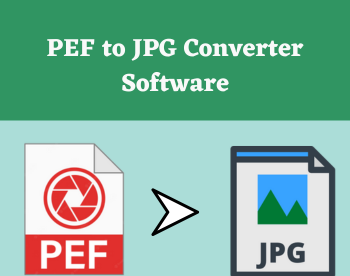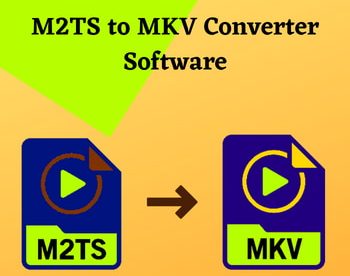7 Best Free Optics Simulation Software For Windows
Here is a list of best free optics simulation software for Windows. The primary purpose of these software is to educate students about optics and how different lenses and mirrors affect light. Using these simulators, you can simulate various different optics scenarios using lenses and mirrors. Along with setting up lenses and mirrors, you can also specify their properties like refractive index, size, type, thickness, etc., for accurate representation. In a typical simulation, you get one light source, an object, and one or more lenses. You can vary the position of lenses or of the light source to observe optics and reflected or refracted image of the object.
Most of these optics simulators also provide various predefined optics simulations. However, you can still change the position of lenses, object, and light sources just like manually created simulations. Some dedicated reflection and refraction based simulations can also be found in these. From software to software, you can find various differences between these simulation software but overall, all of these are used for optics simulation. Go through this list to know more about each individual software.
My Favorite Optics Simulation Software For Windows:
Algodoo is my favorite software because it provides the most number of realistic optics simulations. In addition to that, it also lets you vary multiple simulation parameters to simulate and observe optics at different values. Along with optics, it contains more simulations related to other fields of science like Pulley, Arch, Planets, etc.
You can also check out lists of best free Flow Simulation, Electromagnetic Simulation, and Gas Simulation software for Windows.
Algodoo
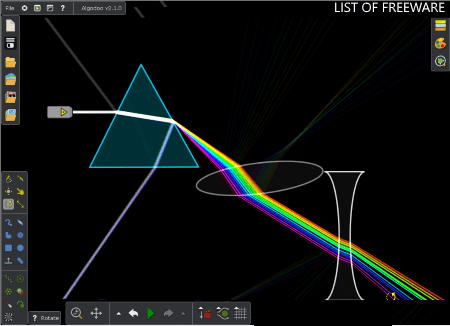
Algodoo is a free optics simulation software for Windows. It is an educational software that contains various prebuild simulations and also provides tools to create various simulations. In it, you can find all kinds of simulations related to Gravity, Gas, Pulley, Arch, Planets, Iceberg, etc. including the Optics. For Optics, it provides five simulation scenes namely Mirror_Laybrinth, Mirror Periscope, Rainbow_scene1, Rainbow_scene2, and Refraction.
Let’s take a look at all five available optics simulation scenes:
- Mirror_Laybrinth: In this simulation, you get a maze structure, multiple flat mirrors, and a single beam light source. The main aim of this simulation is to show the light reflection and its properties. In it, you can place mirrors in the path of light at an angle so that light reflects towards a specific direction. By successfully placing all mirrors in the right position and at the correct angle, you can make the light beam to exit the complex maze structure.
- Mirror Periscope: It is a very simple simulation, in which you can simulate the working of an actual periscope. In this simulation, you get two single beam light sources, a periscope structure, and two lenses to reflect light from one side of periscope to another side. You have the complete freedom to vary the distance of light source, the angle of lenses, and position of lenses to create multiple scenarios.
- Rainbow_scene1: In it, you get to simulate the dispersion of white light to seven colors (rainbow) with the use of a Prism. Along with prism, you can add concave and convex lenses to simulate the refraction of light.
- Rainbow_scene2: In this simulation, you can simulate the dispersion of white light to seven colors with the use of a cylindrical lens. Plus, you can also observe some reflection from the outer surface of the cylinder and some leaked internal refraction within the cylinder. Here, you can change the position of both the lens and light source to simulate different situations.
- Refraction: It is a very basic simulation where you get three rectangular glass slabs and a single beam light source to simulate the behavior of light in the dense and thin medium. As you know, light beam changes its direction when going through light to dense medium or vice versa. Like other simulations, you can change the position of all three glass slabs and of the light source.
The optics simulation is a very small part of this software as this software contains a lot more simulations related to other physics topics. Plus, a lot of simulation creation tools are also provided by it to build simulations which is another handy feature of this software. Overall, it is a great optics simulator software to learn about lens optics and behavior of light.
Student Physics Optics

Student Physics Optics is a free optical simulation app for Windows 10. This app is primarily built for students so that they can perform various optics simulations and calculate geometrical optics exercises. In it, you get four separate sections to deal with different optics.
Let’s take a brief look at all four simulation sections of this app:
- Mirrors: In this section, you can simulate optics of concave and convex mirrors. To start the simulation, first, you need to provide some parameters namely subject distance, object size, and image distance. According to the input parameter values, you will get the corresponding optics simulation showing the object, reflected light, and focal point. Apart from simulation, a mathematical solution describing the process to get output parameters namely focal point, magnification, and image size are also provided.
- Lens-display: This section is used to simulate optics of concave and convex lenses. By providing either the subject distance, object size, image distance or image size, magnification, focal length, and subject distance values, you can simulate a lens optics simulation. Plus the complete mathematical solution is also provided by it.
- Refraction and Reflection: According to its name, you can simulate refraction and reflection of rays by providing input values named as angle of indices, angle of reflection, angle of refraction, index of first & second media.
- Lens-focus: This section does not provide optics simulation like other sections, instead it provides the right focal length and shape of the lens according to input parameters (refractive index of lens material, image radius of curvature, object radius of curvature, etc.).
In general, it is a really beneficial app for students who want to learn about optics and the mathematical operation behind the results.
Spherical Mirror Model

Spherical Mirror Model is a free open source optics simulation software for Windows. The main task of this simulator is to simulate the focusing of light using a spherical mirror. This simulation contains two main elements namely a light source or object and a spherical mirror. In the simulation, you can view the behavior and path of light rays after the reflection from the spherical mirror. At any time, you can change the distance and size of the object along with the focal point of rays to create different scenarios. As soon as you change any parameter an immediate change in the behavior of light can be observed.
This software also provides options to simulate the focusing of light in ideal and actual scenarios to analyze the difference between both situations. Plus, some additional options including Show Image (to view the point where image will be formed), Cental Ray (to highlight the central ray), Parallel Ray (to highlight the parallel ray with the ground), and Multiple Rays (to view the path and behaviour of multiple rays at a time) are also available.
Geometric Optics

Geometric Optics is a free web-based optics simulation software for Windows. It is also a Java based software that requires both Java and Adobe Flash player to work.
This simulator is used to create various scenarios in order to analyze and understand the behavior of light, refraction, and optics. In order to simulate the optics and light behavior, it provides an object and a convex lens in the simulation. The rays of light that go from object to convex lens create an upside-down image of the object on the other side of the lens. You can change the position of the object to see the changed output image in the real time. There are more handy parameters that you can vary to make changes in the simulation like curvature radius, diameter, refractive index of the lens, marginal rays, principal rays, etc. According to changes in parameters, you can observe the corresponding change in the output simulation.
Overall, it is a very good simulator to understand about optics, light, and lens refraction.
OpticalRayTracer
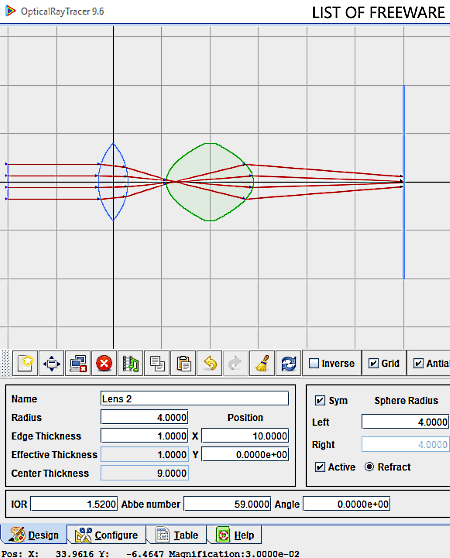
OpticalRayTracer is yet another free Java based optics simulation software for Windows. Using this simulator, you can easily simulate the optics and effects of optics of different lenses like convex, concave, flat, curve, etc., on the light. In it, you can create combinations of various lenses and mirrors to create custom optics simulation. Plus, properties of the lenses and mirrors like radius, edge thickness, center thickness, position, curvature class, hyperbolic factor, etc., can also be varied. Now to specify the object, its position, light beam count, beam width, etc., you can use the Configure section of this software. According to specified lens and object configurations, you will get the corresponding optical ray simulation on its interface. In general, it is one of the most configurable optics simulation software in which you can create unlimited lens-object scenarios and see the effect of each scenario on the optics and light beam direction.
Opt-Sim
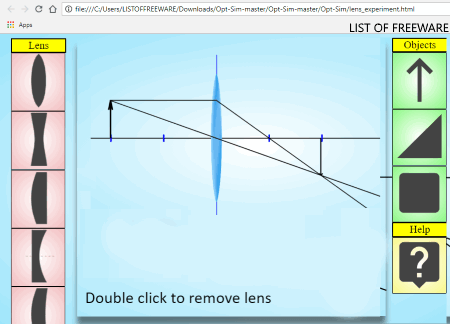
Opt-Sim is a free open source web-based optics simulation software for Windows. It is a simple and straightforward optics simulation software that lets you create various optical scenarios by using multiple lenses and an object. To create different combinations, this software provides five different lenses and three objects.
To create the simulation, first, drop one or more lenses on its interface and place them in the right position. After that, double-click on one of the three available objects to add it to the interface. Now, to get optics simulation, just move the object closer to or far away from the first lens to observe the changing path of light rays and the corresponding output image of the object. You can also move lenses without moving the object to simulate different scenarios. Overall, it is a basic optics simulation through which you can easily run optical experiments and learn more about the nature of optics of different lenses.
Ray Optics Simulation
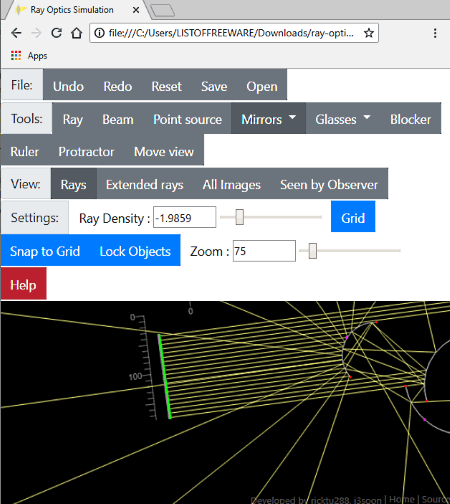
Ray Optics Simulation is another free open source web-based optical simulation software for Windows. This software is built to simulate various refraction and reflection scenarios. In it, you don’t get any pre-built simulation, hence you need to create a simulation using various available tools. Some of the important tools that you get in it are Ray (ray of light designed by two points), Beam (it emits multiple parallel beams), Point Source (it emits light beams in all direction), Arc & standard mirrors (to simulate reflection), Lens (to simulate refraction), etc. Besides these tools, you also get ruler and protector tools to measure certain parameters for accurate simulations.
To create optics simulation, you can easily select and add any desired lens and light source tool to the interface from the Tools menu. After that, you can set every tool to its right location using the mouse to create the final simulation design. After creating the simulation, you can use its View menu to view only extended rays, rays, all images (to only view lens and mirrors without any light), and Seen by Observer (to observe the simulation from a specific location.). Overall, it is another really nice optical reflection and refraction simulation software.
Naveen Kushwaha
Passionate about tech and science, always look for new tech solutions that can help me and others.
About Us
We are the team behind some of the most popular tech blogs, like: I LoveFree Software and Windows 8 Freeware.
More About UsArchives
- May 2024
- April 2024
- March 2024
- February 2024
- January 2024
- December 2023
- November 2023
- October 2023
- September 2023
- August 2023
- July 2023
- June 2023
- May 2023
- April 2023
- March 2023
- February 2023
- January 2023
- December 2022
- November 2022
- October 2022
- September 2022
- August 2022
- July 2022
- June 2022
- May 2022
- April 2022
- March 2022
- February 2022
- January 2022
- December 2021
- November 2021
- October 2021
- September 2021
- August 2021
- July 2021
- June 2021
- May 2021
- April 2021
- March 2021
- February 2021
- January 2021
- December 2020
- November 2020
- October 2020
- September 2020
- August 2020
- July 2020
- June 2020
- May 2020
- April 2020
- March 2020
- February 2020
- January 2020
- December 2019
- November 2019
- October 2019
- September 2019
- August 2019
- July 2019
- June 2019
- May 2019
- April 2019
- March 2019
- February 2019
- January 2019
- December 2018
- November 2018
- October 2018
- September 2018
- August 2018
- July 2018
- June 2018
- May 2018
- April 2018
- March 2018
- February 2018
- January 2018
- December 2017
- November 2017
- October 2017
- September 2017
- August 2017
- July 2017
- June 2017
- May 2017
- April 2017
- March 2017
- February 2017
- January 2017
- December 2016
- November 2016
- October 2016
- September 2016
- August 2016
- July 2016
- June 2016
- May 2016
- April 2016
- March 2016
- February 2016
- January 2016
- December 2015
- November 2015
- October 2015
- September 2015
- August 2015
- July 2015
- June 2015
- May 2015
- April 2015
- March 2015
- February 2015
- January 2015
- December 2014
- November 2014
- October 2014
- September 2014
- August 2014
- July 2014
- June 2014
- May 2014
- April 2014
- March 2014
